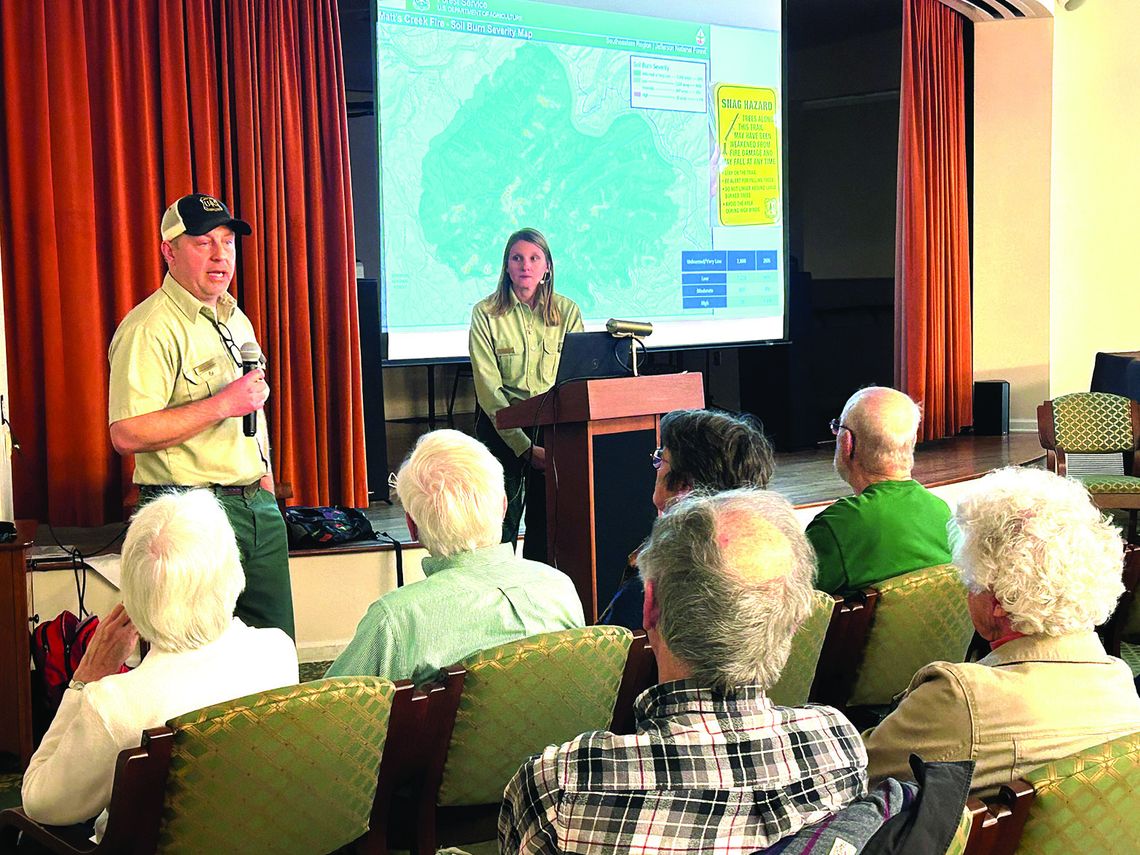Forest Officials Recap Matts Creek Fire Efforts
“This was overall a really big success story for us,” U.S. Forest Service Ranger Lauren Stull said of the Matts Creek Fire at an event hosted by Kendal last month.
The Matts Creek Fire, which originated in the James River Face Wilderness in the Washington and Jefferson National Forest in November of 2023, burned over 11,000 acres before teams of firefighters, brought in from around the country, were able to contain it.
In her talk at Kendal, Stull, ranger with the Glenwood-Pedlar Ranger District, reviewed the Forest Service’s changing strategies for dealing with the fire, as well as its efforts to limit the damage to resources.
“All the conversations in November in our office were related to the weather and how dry it was,” she said. “At the time of the Matts Creek wildfire, it had been 30 days since we’d had significant rainfall.”
Even before the fire, officials were readying resources.
“We were all aware that it was dry, knowing what was going on, watching closely. We even started bringing in some outside resources,” said Stull.
“We had some large helicopters that were here on the forest because it was so dry, and we had some crews that were here from, typically, the Western United States, to help us out.” Those crews were alerted to the Matts Creek Fire on Nov. 12, and though firefighting efforts began quickly, they soon realized they would need more resources.
“Our first approach was, ‘Let’s go drown this thing with a lot of water; it keeps our resources out of there; we don’t have to put a lot of firefighters in the middle of the wilderness.’ We said, ‘Let’s try that; let’s use the Appalachian Trail as one of our potential containment lines,’” Stull said.
“So we sent a few folks in, and we put a lot of water on it, and this thing just didn’t want to cooperate. It was very dry,” she said. “Our folks made very good progress on using the Appalachian Trail as a containment line, but the fire kept growing overnight when we couldn’t keep people in there, and when we couldn’t keep people putting water on it.”
Stull spoke of “building the box,” or creating lines of containment around the perimeter of the fire.
“On one side of the fire, we have this great natural barrier, the James River. On the other side of the fire we have a man-made barrier that we frequently use for fires, which is the Blue Ridge Parkway, and then we were able to piece some other roads together,” she said.
“We started building this box but we knew we needed more help, and so at that point what we do is, we look at all the factors we’re dealing with, and we say, ‘Hey, this fire is more complex than we can handle here locally.’” An incident management team was called in to supervise firefighting efforts, as well as planning and logistics.
“These folks come from across the country. Some of them are Forest Service employees who are local, some of them are state employees, some of them are retirees, and they put their name on a list and say, ‘I’m willing to leave at Thanksgiving and go help another community out,’” she said.
Looking at progress on containment and at weather patterns, the incident command team made the decision to do a controlled burn.
“We had most of the box constructed,” she said. “The team was able to help us get the additional resources and firefighters that we need, we were finally starting to meet the public’s demand for information, and we had an opportunity.
“We had a containment way down here, and we had fire way up here on the mountains, and we saw some weather. We’re like, ‘Hey, there’s rain coming in a day or two or three,’ and the other thing we could see was that there was a front, potentially coming with that rain, and there might be some wind.
“We had an opportunity to go in and do a burnout, and basically bring the fire all the way down to our containment lines on our terms,” Stull said.
Rainfall helped to put out what fire remained within the box, and to mitigate the smoke, which had been significant in Rockbridge, leading to Lexington, Rockbridge and Buena Vista schools closing for multiple days due to health risks.
Looking back, Stull said cooperation among government agencies and within the community produced a successful ending.
“Things went well. And things went well because of the relationships and the partners that we had,” she said.
“All of our partners, from folks at the Appalachian Trail club, Blue Ridge Parkway, Rockbridge County emergency management, we just had amazing support from all of our partners. We just had so much community support, and so many relationships and help from partners, it was tremendous.”
During firefighting efforts, teams were working to protect what resources they could, as Danny Wright, wildlife biologist with the Glenwood-Pedlar Ranger District, explained.
“One role that I typically fall into during a wildfire event, especially a large wildfire event, is this resource adviser role,” he said.
“I get to be in the field, looking at fire effects, what’s going on with the fire,” he said. “I get to come back to the incident command and weigh in with the team and help develop the plan, and then at the end of the fire, it’s my job to assess whether there’s rehabilitation needs, either from the fire or from our suppression actions, and then maybe is there will be long-term monitoring.”
Rehabilitation efforts began even before the fire was fully out.
“The other thing we were starting to do as that rain came in is what we call our BAER program; it’s not a bear like a black bear, its Burned Area Emergency Response,” said Stull.
“While the fire was still going, we put together this emergency response team and they came out — there were hydrologists, engineers, our trail specialist — they put together this fancy product, where they use satellite imagery to make a soil burn severity map.”
This map, Stull said, showed that though the fire covered a large area, its impacts were mostly not severe.
“When you go and you look at the soil burn severity for the James River Face Wilderness during the Matts Creek Fire, almost the whole thing was low to very severity,” she said.
“There’s some pockets, there’s less that 1% of that whole 11,000 acres burned at high severity, and then less than 10% is at moderate. In the grand scheme of things, you don’t have devastation, destruction out there.”
Stull said she expected the area to largely recover come spring, but warned hikers to be cautious around trees that may have been damaged in the firefighting efforts.
The cause of the fire, she noted, is still under investigation.





